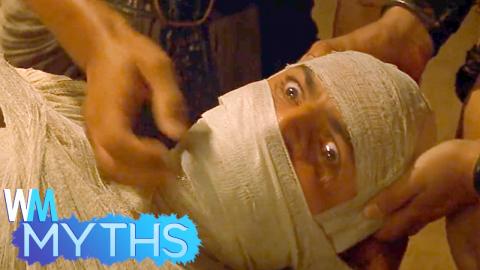Top 5 Myths About Ancient Egypt

What do you get when you combine mysterious tombs, massive structures and cryptic symbols? A whole lot of exaggerations. Welcome to WatchMojo's Top 5 Myths. In today's instalment we're counting down the top five myths about Ancient Egypt that should be mummified - and (spoiler) none of them have anything to do with aliens.
Special thanks to our user Swiss Bailey for submitting the idea on our interactive suggestion tool: WatchMojo.comsuggest
#5: Cleopatra Was A Great Beauty
Historically, cultures have strongly disagreed on the standards of beauty. But Cleopatra’s looks were the stuff of legend, both in her time and in centuries since. Her beauty was described as unparalleled and utterly captivating – and surely she must have been to catch the attention of both Caesar and Antony. But her face, as depicted on ancient coins, had a sharp, hooked nose and arguably mannish features. The Greek historian Plutarch, on her beauty, said it was “in itself not altogether incomparable, nor such as to strike those who saw her”. The general consensus? She probably had an unremarkable physical appearance - but her charisma, charms, wit and power made her incredibly attractive. Fun fact: Though she ruled Egypt, she was of Macedonian descent.
#4: Napoleon and His Troops Shot Off The Nose Of the Sphinx
Speaking of noses… how exactly did this mythical, riddle-asking beast lose his? The monuments of Ancient Egypt are architectural marvels that have stood the test of time and captivated the attention of travellers from the around the globe for centuries. Meaning that if you mess with them… the world does not forgive. And Napoleon is a historical figure who needs little help inspiring dislike. Blame him for breaking countless treaties, reinstating slavery in Haiti and the death of some 6 million Europeans, but not the sphinx’s botched rhinoplasty job. Napoleon embarked on an Egyptian Campaign in 1798, and so the damage was attributed to him retroactively. But sketches of the sphinx published in 1757 already included a missing nose, a timeline other accounts from that time can corroborate.
#3: When a Pharaoh Died, Their Servants Were Buried With Them
It just takes a few eccentrics to tarnish the reputation of an entire civilization. We’ve all seen it in movies and television - a pharaoh is embalmed, placed in an ornate sarcophagus, and then buried in a massive tomb worthy of their status. Their servants place their greatest possessions around them, and then the tomb is sealed… with the servants inside! Up until the inclusion of the servants, this account of a ritualised pharaoh burial was accurate. But most pharaohs took small figurines with them to the grave, known as “shabtis”, symbolic servants to serve them in the afterlife. Only two or three pharaohs of the first dynasty insisted on bringing real servants along, but the discovery of these specific tombs inspired generalisations about the practice.
#2: Egyptians Invented Hieroglyphs
Ancient Egypt has certainly provided modern researchers with an ample reading material to study in the form of hieroglyphs. This pictorial language, first deciphered by Jean-Francois Champollion in 1820 using the Rosetta Stone, was the formal writing system of Ancient Egyptians. For many years, it was considered the oldest written language. But there is a curious lack of proto-glyphs in Egyptian artefacts - the glyph system appears suddenly in their history between 3400 and 3000 BCE, already fully developed. Contemporary scholars now believe that this language, or at least, the concept of a pictorial script, was introduced to Egypt by the Sumerians, whose cuneiform seemingly predates Egyptian hieroglyphs. According to the Ancient Egyptians however, the god, Thoth, invented it.
#1: Slaves Built The Pyramids
You have the Greek historian Herodotus to thank for this myth, who first described the pyramids as “slave built” around 450 BCE. He was, however, known to exaggerate. He also claimed they used a workforce of 100,000 men, when it was actually closer to 30,000. The construction of the pyramids was certainly backbreaking labour, but it was carried out by skilled artisans and paid workers. In the 1990s, the tombs of these workers were discovered near the pyramids, and the respect with which they were buried was well above the “slave standards” of the time. According to Amihai Mazar, an archaeologist at the Hebrew University of Jerusalem, the idea that Hebrew slaves built the pyramids is a work of fiction, which Egyptologists blame Hollywood films for popularizing.
